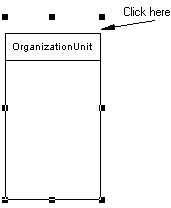

Chapter 6 Building an Analysis Business Process Model
You can modify an object's properties from its property sheet. To open an organization unit property sheet, double-click its diagram icon symbol or its Browser entry in the Organization Units folder. The following sections detail the property sheet tabs that contain the properties most commonly entered for organization units.
When the organization unit is a swimlane, you do not open its property sheet by double-clicking the object as you do for any other PowerDesigner objects.
![]() To open an organization unit swimlane property sheet:
To open an organization unit swimlane property sheet:

The following table details the General tab that contains the properties most commonly entered for organization units:
| Property | Description |
|---|---|
| Name | The name of the item which should be clear and meaningful, and should convey the item's purpose to non-technical users |
| Code | The technical name of the item used for generating code or scripts, which may be abbreviated, and should not generally include spaces |
| Comment | Descriptive comment for the object |
| Stereotype | Extends the semantics of an object derived from existing objects but specific to your needs. You can type stereotypes directly in the Stereotype box of the object property sheet or select a value from the list if you have previously defined stereotypes in an embedded or imported extended model definition (.XEM) or in the process language. An organization unit has the following predefined stereotypes:
|
| Parent organization | Displays the parent organization unit. The list contains all organization units in the model. Each time an organization unit is selected, it becomes the parent of another organization unit, the latter becoming the child. This relationship is also displayed in the Organization Units sub-tab of the Dependencies tab in the property sheet of the child organization unit |
| Copyright (C) 2005. Sybase Inc. All rights reserved. |

| |